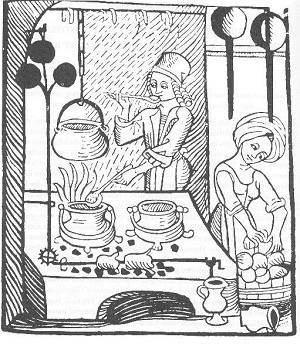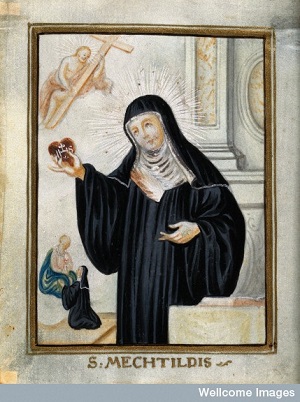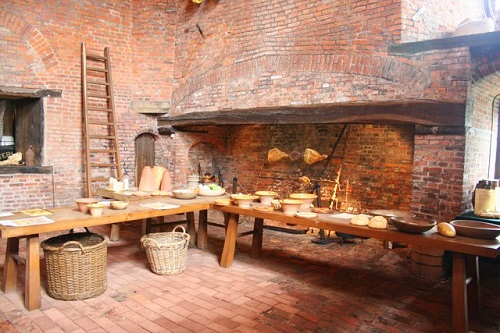Saint Mechtildis, Iconographic Collections ICV No 33837. Image from the Wellcome Library, London
When I set out to write a doctoral thesis on the subject of household imagery in Middle English devotional texts, I’m not sure I was expecting to find such a huge number of domestic metaphors, allegories and allusions. At the very beginning of my project, I would sit with a large pile of texts on my desk, and read through each one with pen in hand, recording in my notebook every homely reference I encountered. It is indeed the case that the imagery of the domestic sphere, whether a brief remark or an extended metaphor, is a pervasive feature of much Middle English religious literature. Salient figures such as Christ and Mary are themselves allegorised in structural terms, as beautiful houses made from precious stones and jewels. Elsewhere, Christ’s heart, pierced during the Passion, is described as a house in which the reader of the text will come to dwell, enclosed within the ultimate symbol of divine love and sacrifice.
Sometimes, I would come across an especially striking domestic metaphor, and record it in my notebook with a large asterisk in the margin, indicating my great hope that there would be an illumination of this particular image in one of the manuscripts of the text. One such example of this was in Bridget of Sweden’s Middle English Liber Celestis, in which Bridget receives a remarkable vision from Saint Agnes of God as a washerwoman, who launders the dirtied cloth of the soul in order to make it clean again. I am, unfortunately, yet to come upon a manuscript illustration of this extraordinary conception of the divine cleansing of the soul as an act of female domestic labour, and Bridget’s image of God as a woman working her way through the laundering of a presumably rather large pile of dirtied souls is joined on my asterisked list by a multitude of other notable household scenes. Some of the most vivid and striking examples of domestic metaphors, which I would certainly love to chance upon in manuscript illumination form, are found in Mechtild of Hackeborn’s Booke of Gostlye Grace. Mechtild, a thirteenth-century mystic, was a nun at the Benedictine convent of Helfta, in Germany, and her Booke is a Middle English translation of the Latin Liber Specialis Gratiae, a collection of her visions. These visions were compiled by the sisters at Helfta, and the language of homes and households is a frequent hallmark of the metaphorical vocabulary of both the Latin Liber and the Middle English Booke. I’d like to discuss just two fascinating examples of domestic metaphor from Mechtild’s vast visionary catalogue, one of which is drawn from her Latin text, and the other from the Middle English translation. These images are indicative, I would suggest, of the power of the household as a space that could define the devotional imaginary, particularly that of the woman writer, as important religious ideas are refracted through a recognisably homely framework.
Medieval kitchen, Gainsborough Old Hall. Image from Wikimedia Commons
The first domestic image that I would like to discuss is found in Mechtild’s Latin Liber, in the second book of seven in total. Most readers of medieval devotional literature are familiar with the notion of Christ’s wounded heart as a dwelling place, with this most famous wound offering the devout dweller warmth and security, while also serving as a reminder of the immense sacrifice made by Jesus. Mechtild’s vision of Christ’s heart, however, has some notably more precise connotations than those of the familiar warmth that one might associate with the broad notion of homely dwelling. For Mechtild, the heart of Christ is, specifically, a kitchen. In the Liber, this vision is headed ‘De Coquina Domini’, meaning ‘God’s Kitchen’, and Mechtild is directed there after declaring herself unfit even to wash Christ’s dishes:
O Rex munificentissime, nequaquam hoc tantae excellentiae tuae donum condecet me, quae indignam me reputo etiam ut immitar coquinae tuae ad abluendas scutellas tuas. » Cui Dominus benigne respondit : « Quae est coquina mea, et quae sunt scutellae meae, quas velles abluere ? »… « Coquina mea est Cor meum deificum, quod in modum coquinae, quae domus est communis et pervia omnibus tam servis quam liberis, semper patens est omnibus et promptum ad cujuslibet delectamentum (165).
O most munificent king, in no way does this gift of your great excellence befit me, who consider myself unworthy even to be sent to your kitchen to wash your dishes.” The Lord kindly answered her: “What is my kitchen, and what are my dishes, which you might wish to wash?” … My kitchen is my divine heart which- in the manner of a kitchen, which is a common home [room in the house] and accessible to all, both servants and free- is always open to all and ready for anyone’s enjoyment (Ray 307).
This remarkable kitchen metaphor evokes a couple of different possibilities for interpretation. Clearly, Christ’s gentle response to Mechtild’s anxiety about her religious shortcomings casts him as a ‘homely’ figure in the sense that Julian of Norwich so often makes use of this word: he is familiar, comfortable, and benevolent. Rosalynn Voaden has read this image as making a specific allusion to the manner in which women might be more ‘aware’ of the kitchen than men, with such household tasks as washing the dishes often gendered as women’s work. Furthermore, with the kitchen located deep within the heart of Christ, and therefore sealed within the external structure of the body, Voaden suggests that the image might have a specific applicability to the enclosure that defined the everyday life of the Benedictine nuns at Helfta. This sense of enclosure, of this kitchen a space of intimacy and familiarity with Christ cocooned within the security of his body, might very well have appealed to some of Mechtild’s later conventual readers. As Vincent Gillespie has noted, Syon Abbey had three copies of the Latin Liber in its library, along with one copy of the Middle English Booke. My own view of this wonderful domestic image is that it neatly encapsulates the multiple connotations of conventual life. It is important to note that, while the kitchen of Christ’s heart is indeed a space of enclosure and intimacy, it is also recognisably communal, vibrant, and diverse: it is ‘open to all’. The kitchen of Christ’s heart, in a sense, is the convent, a space that can be simultaneously defined in terms of solitude and community.
Alongside this image of Christ’s heart as a kitchen, I would like to discuss one further image, in this instance drawn from the Middle English Booke. Once again, Mechtild’s vision draws upon the experience of the space of the kitchen, but has, I would suggest, some altogether different resonances from the heartly kitchen of the Liber. Shortly after Mechtild has finished saying Matins, she has a vision of Christ sitting in a high seat, and he speaks to her:
A stole he hadde vundere his feete ande he spake to here ande sayde: ‘Reste the here opon my feete and slepe.’ Sche obeyede anone ande lenede here hede on his feete so þat here eere was euen to the wounde off his feete. And þan sche herde þat wounde make a noyse als of a potte feruently boylynge (339.9-14).
He had a stool under his feet, and he spoke to her and said, ‘rest here upon my feet, and sleep’. She obeyed, and laid her head on his feet so that her ear was over the wound in his foot. And then she heard the wound make a noise, like that of a pot boiling fervently (my translation).
This image is a jarring juxtaposition of the familiar and the peculiar. To sit or lie at Christ’s feet is a recognisable image from the Bible, with Mary, sister of Martha, positioning herself there in Luke, 10:39. The very act of sleeping upon Christ’s feet, moreover, suggests intimacy with him, and that one is comfortable in his presence. In this image, however, domesticity does not exclusively denote familiarity. Oddly, Mechtild does not sleep in peaceful comfort when she lies upon the feet of Christ, but rather hears the sound of a boiling pot. In inserting such a recognisably domestic sound into the wound in Christ’s foot, Mechtild is perhaps underscoring the importance of becoming ‘homely’, and thereby familiar, with the sacrifice and suffering that the wounds connote.
Perhaps unsurprisingly, Mechtild seems confused by the fact that she can hear the boiling pot from within the wound, and asks Christ to tell her what it means. He answers, telling her:
A boylynge potte sowneth as ȝif he sayde þus: Renne, renne, fro trauayle to trauayle, fro cite to cite, fro prechynge to prechynge (339.18-20).
A boiling pot sounds as though it is saying this: Run, run, from city to city, from labour to labour, from sermon to sermon (my translation).
I find Christ’s explanation of the significance of the boiling pot fascinating, because it doesn’t at all connote what one might expect. This most domestic of images does not carry resonances of the interiority of the household, or even the broadest sense of enclosure. Rather, the boiling pot seems to encapsulate a notably mendicant understanding of what it is to be a good Christian, and therefore symbolises a mode of devotional practice that is defined by exteriority and the absence of a home.

Anonymous: Kuchemaistrey, Nuremberg, 1485. Image from Wikimedia Commons
Examining these images in tandem with one another is indicative of the extent to which domestic imagery in medieval devotional literature has a broad range of resonances. In the kitchen image from the Liber, it multifariously encapsulates enclosure and openness, solitude and community. In the case of the boiling pot in the Booke, it becomes a conduit for Mechtild to imaginatively experience a model of devotion that is so very different from her own. As an enclosed Benedictine nun, Mechtild would not have been able to literally run between cities and preach, but the sound of the boiling pot enables her to do so in a figurative sense. Domestic images, I would suggest, can often facilitate the transcendence of psychological borders between interior and exterior, real and imagined, familiar and unfamiliar, and they therefore enrich the spirituality of the religious women who so often craft them so beautifully.
Louise Campion


